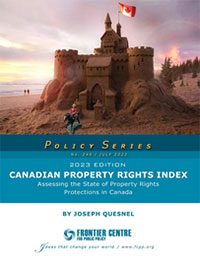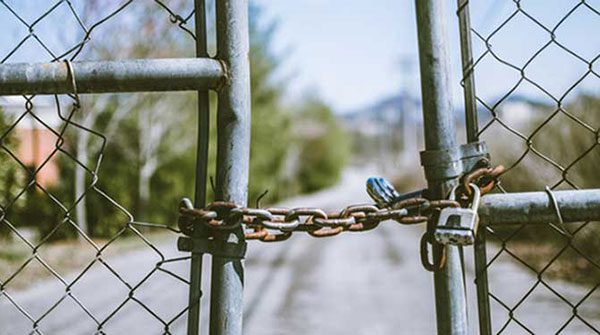- Canada’s property rights slipping behind global competitors
- A citizen-led movement key to protecting property rights in Canada
- Manitoba’s prosperity tied to property rights protection
- Strengthening property rights part of the answer to Canada’s housing crunch
- Public’s role is crucial in upholding property rights
- Supreme Court’s Annapolis ruling a win for property owners
- Property rights in Canada are a constitutional necessity
- Property rights in Canada are continuously being eroded by governments
Canadian Property Rights Index exposes the precarious state of property rights in Canada
 When the protection of rights is subject to the whim of politicians and policymakers, one might question whether they can be considered rights at all. The solution is a proactive and vigilant public to highlight areas of weakness and demand appropriate action from the government to address them.
When the protection of rights is subject to the whim of politicians and policymakers, one might question whether they can be considered rights at all. The solution is a proactive and vigilant public to highlight areas of weakness and demand appropriate action from the government to address them.
This is one of the central takeaways of the recently released Frontier Centre for Public Policy’s Canadian Property Rights Index.
First launched in 2013 and having undergone revision for this year’s release, the Index provides disturbing evidence of the precariousness of our property rights, with ongoing legislative efforts aiming to erode our rights. The highest ranking given to any jurisdiction in Canada is a mere B+, indicating substantial room for improvement.
A key insight from the Index is the uneven enforcement of property rights across provinces. A high score generally requires consistent high performance across all aspects, yet inconsistencies can obscure significant shortcomings. For instance, British Columbia ranks highly, despite the controversial issue of regulatory takings – which occur when regulations enacted by the government prevent a property owner from making any beneficial use of their property. In other words, the government has, effectively, taken the property. BC’s Agricultural Land Reserve (ALR), which restricts land rights and removes potentially valuable housing land, is a glaring blemish on the province’s record.
 In the 2013 index, Dr. Tom Flanagan, a renowned political scientist from the University of Calgary, pointed out that there’s a lack of coherence in Canadian jurisdictions’ approach toward property rights. As he described, the absence of a common data structure suggests that lawmakers address these issues in isolation rather than striving for uniformity across the board. As he put it, “The absence of internal data structure suggests that legislatures, when they act in this field, view the issues in isolation rather than seeing them as belonging to a broader field on which they should strive for consistency.”
In the 2013 index, Dr. Tom Flanagan, a renowned political scientist from the University of Calgary, pointed out that there’s a lack of coherence in Canadian jurisdictions’ approach toward property rights. As he described, the absence of a common data structure suggests that lawmakers address these issues in isolation rather than striving for uniformity across the board. As he put it, “The absence of internal data structure suggests that legislatures, when they act in this field, view the issues in isolation rather than seeing them as belonging to a broader field on which they should strive for consistency.”
Such a lack of integration is understandable, given that politicians and policymakers often see the seven areas covered by the Index as distinct. For example, civil forfeiture deals with crime control, while heritage designation is about preserving historical buildings for future generations. Despite the different policy goals, all these areas involve governmental decisions that can limit property ownership and usage.
However, in all cases, governments can introduce procedural measures to safeguard individual property rights. It is our hope that the Index will awaken the public to the importance of their property rights and the need to push the government to commit to protecting these rights across all policy areas.
However, without constitutional guarantees, it’s unlikely that politicians will willingly curb their own powers. Governments tend to seek to limit their responsibilities toward the public, especially if those responsibilities incur a financial cost.
For example, governments want to make expropriations easier and cheaper to do. For regulatory takings, they want fewer obligations to compensate the public when regulations impose a cost on property owners. In the case of civil forfeiture, the government wants to make it easier to gain title and make the burden of proof much less onerous on politicians and bureaucrats.
This flaw is common to governments of all political stripes. Thus, expecting any government or political party to spontaneously understand the importance of self-restraint and the protection of property rights is unrealistic, particularly when it might limit their control and increase costs.
It falls upon the public to serve as the government’s watchdog. They must regularly scrutinize government policies and evaluate their impact on individual property rights. This highlights the importance of independent, pro-market think tanks and scholars who, without accepting government funds, can monitor property rights consistently.
As we’ve stated before, the solution lies in consistent public policy implementation affecting property rights, fueled by a well-informed public. It’s crucial that both the public and governments stay vigilant, as property rights are integral to our prosperity. Ensuring their consistent protection across all jurisdictions is in everyone’s best interest.
Joseph Quesnel is a senior research associate with the Frontier Centre for Public Policy. He is the author of the newly revised Canadian Property Rights Index.
For interview requests, click here.
The opinions expressed by our columnists and contributors are theirs alone and do not inherently or expressly reflect the views of our publication.
© Troy Media
Troy Media is an editorial content provider to media outlets and its own hosted community news outlets across Canada.



